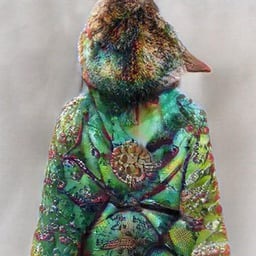one passage I read warned that anyone who got too deep into studying mushrooms very quickly started to sound like they had gone off the deep end …
Can confirm. I’ve been curious about mushrooms for years and joined a mushroom pick. There’s another guy who is normal like me. But everyone else, I’m 90% sure are forest druids and like a slow zombie bite, I’m already seeing myself become a crazy kook.
Can you provide an example with a mushroom rambling or similar level ramble?
Removed by mod
Mushroom, MUSHROOM
This is the sort of thing the cranky old wizard says to the hero before inevitably teaching them about mushrooms so they can go on a magical adventure
Mushrooms took me on a magical adventure where I met a wizard.
I used to be a wizard, till I took a mushroom to the knee.
Well there’s your problem. You’re supposed to use the mushrooms orally, not topically.
Pretty sure you can use some mushrooms topically 😉
That gets a stamp of approval
My best trip had three things appear in the branches of the trees I was sitting under: A wizard, Bob Marley, and Optimus Prime.
It felt like a combination that could guard me against literally anything.
Ah the holy trinity.

not a lot of people are mentioning the sex and gender aspects of mushrooms.
“Mushroom cellar! I am going into battle and need your strongest mushrooms.”
“…”
“I am talking to a dark room. Perhaps I already took strong enough mushrooms.”
Just give me the mushrooms that’ll make me see the curvature of the universe fam
My mushrooms are too strong for you, traveller
But I am going into BATTLE >:(
My strongest mushrooms would kill you, traveler. You can’t handle my strongest mushrooms. You’d better go to a seller that sells weaker mushrooms.
3 grams of Penis Envy will put you on the right direction
Is this professor Paul Stamets?
You mean The Professor Paul Stamets, who wears a big hat that is one big mushroom? The one with a species of mushroom named after him? The one with honorifics in warp speed pop culture, and those who feed lemmings memes?
Cuz he’s a cool dude.
The coolest. (That’s a pretty big list, but still barely scratches the surface!)
deleted by creator
AFAIK, the professor came first. The character and drive are presumably named for him.
I legit didn’t know about the mycologist. I was checking the spelling after I posted and found him, and then felt like an asshat
It was
I always liked the theory that fungi are actually aliens that came from some asteroid from another planet and have just been around long enough that nobody bats an eye at them anymore. I mean, look at slime mold and tell me that not basically Venom!
Slime mold is a protist not fungi :0. I’m just being a jerk here doesn’t matter lol. I love the slime molds they’re so cool I always liked having them in the lab each year as a teaching tool. Definitely venom
Correcting phylogenical errors is never being a jerk.
It’s just nit picking but I put in here because it’s somewhat interesting that it isn’t. I try not to be the well ACKSHULLY guy haha
I mean it isn’t exactly nitpicking, is it? Sure, we don’t tend to care that much about protists vs algae vs bacteria vs anything else that is tiny in common parlance, but these things are all VERY different from each other, aren’t they? Like, different kingdoms different? I mean, if someone ran around saying that rabbits were a form of reptile I wouldn’t think you were nitpicking for correcting them as being a mammal.
Have you ever heard about the blob?
It’s a giant single cell intelligent organism that can move, learn, remember things, solve problems and teach others.
Neither an animal, plant or fungus the blob favorite snack is oatmeal but it hate coffee.
Is there really a mushroom that will make your body irritated because it’s so similar?
Honestly, I’m not a mycologist, so someone with more expertise feel free to correct me, but I’m pretty sure that’s BS.
The concept of a mushroom being generally similar to humans is total horseshit. What they’re probably referencing is a mushroom with some signaling protein (or saccride or steroid or something) that is coincidentally similar some human equivalent and your immune system (for some reason) freaks out about it when you eat it. Then, as is referenced, the response to the mushroom happens to also be able to target some of your own cells, and now you’ve got an autoimmune disorder.
That behavior is not normal for your immune system to do, by the way, otherwise cannibals would all die from allergic reactions to their unfortunate meals. But, the immune system is complicated, so shit happens sometimes.
I think that they are referring to Paxillus involotus
It is quite an interesting mushroom. It was considered “safe to eat” for a long time, but it contains an antigen that a human’s immune system can learn to attack.
The antigen is still of unknown structure but it stimulates the formation of IgG antibodies in the blood serum.
I once looked into whether this immune response builds up over many exposures, or if it is a random event that has a probability of happening for each exposure. I don’t remember finding a convincing answer… If it is a random event, then mushroom could be considered a “Russian roulette” mushroom that will usually provide a nice meal, but, if unlucky, you may experience the following:
Poisoning symptoms are rapid in onset, consisting initially of vomiting, diarrhea, abdominal pain, and associated decreased blood volume. Shortly after these initial symptoms appear, hemolysis develops, resulting in reduced urine output, hemoglobin in the urine or outright absence of urine formation, and anemia. Hemolysis may lead to numerous complications including acute kidney injury, shock, acute respiratory failure, and disseminated intravascular coagulation. These complications can cause significant morbidity with fatalities having been reported.
I agree with you that this is probably unrelated to the “generally similar to humans” comment. I feel like this fantasy is a combination of the above fact mixed in with the fact that the Fungi belong to the Opisthokonts, which places them closer to animals than plants, and so they share some interesting cellular characteristics with us. This places them closer to animals than plants, but “generally similar to humans” is perhaps a bit of a stretch _
But, it is just a meme about a guy being hyped about mushrooms. Hopefully people don’t expect memes to be super accurate 😁
There are fungal infections that cannot be treated as there are no good targets for fungicides that don’t also affect humans
I mean, yeah, but that’s on the level of “because they’re eucaryote” like us and all plants and animals, as opposed to bacteria which are procaryote. It’s not really some freakish similarities.
That’s just a long way of saying the same thing. Not as catchy imo.
deleted by creator
The way in which organisms recognize “their own” vs outsider stuff is a different and complex topic, at least as fascinating as fungi.
Liquid brains, solid brains | Philosophical Transactions of the Royal Society B: Biological Sciences
Cognitive networks have evolved a broad range of solutions to the problem of gathering, storing and responding to information. Some of these networks are describable as static sets of neurons linked in an adaptive web of connections. These are ‘solid’ networks, with a well-defined and physically persistent architecture. Other systems are formed by sets of agents that exchange, store and process information but without persistent connections or move relative to each other in physical space. We refer to these networks that lack stable connections and static elements as ‘liquid’ brains, a category that includes ant and termite colonies, immune systems and some microbiomes and slime moulds. What are the key differences between solid and liquid brains, particularly in their cognitive potential, ability to solve particular problems and environments, and information-processing strategies? To answer this question requires a new, integrative framework.
Isn’t there some conspiracy theory about how mushrooms secretly rule the world?
No. Stop asking questions.
Sincerely, the mushrooms.
For some reason, I now have the urge to bury you in wet shady soil.
That’s the mycelia talking…
There’s a fun movie: https://www.imdb.com/title/tt11881160/

What?
A movie about fungi. I can’t say more without spoilers.
Immortal mushrooms? Like some quill does? Googling it is spammed by “mushroom of immortality” because of some chinese legend. But may be the same thing.
So most fungi do have a lifespan, they have teleomere decay, and when you’re cloning mushrooms (from propagating mycelia) you have to let them go to fruit (the part that looks like a mushroom) every now and then. It’s a pain in the ass.
But like the other poster said, they play it fast and loose with which part you consider the “organism”. My favorite thing is that they do cytosolic streaming. Genetics can be a pain on mushrooms because not only do they share nutrients and metabolic burden through mycelia, they can share nuclei.
One of the weird convienent realities we used extensively is that cells are big enough you can spread them over a petri dish with a little loop, and if you diluted the initial sample enough, the colonies that developed were, practically speaking, from one parent cell. So you could try to modify a bunch, and then plate them (spreading the cells around) and pick individual colonies that were all clones from a single parent. Fungi mycelia means the nucleus isn’t stuck in one cell. It also means expression levels can be variable (some cells will have multiple nuclei, and then later maybe they don’t).
Fungi are a godamn pain in the ass to study. They’re not mysterious, they’re not alien, they’re just fucking assholes.
Being a mycologist sounds a lot like being a mechanic who works on German cars
Based on the Wikipedia article on biological immortality referencing species that live for a couple hundred years and the Wikipedia page on armillaria ostoyae mentioning living specimens that are multiple millenia old (and thousands of acres large!), I’m guessing that may be what the prof is referring to?
I’m guessing they’re talking about clones?
Yeah, lots of living beings do that.
Not clones, more of a ship of Theseus scenario. A fungal network can be “one thing” because we see it as a single interconnected system. But parts grow and die over time. It doesn’t have individual cells that are infinitely old, but the one wholistic fungal organism, as we define it, can live forever through regrowth. There are types of jellyfish that can also “live forever” in this same way.
Botanists call this “cloning”.
Like when you cut a bit off one plant and make a new plant you have 2 plants but they’re genetically identical.
There’s never two fungi here though, the mycelium is always continuous. There’s never another individual structure either, like ribosomal cloning, it’s just more hyphae.
Amazing.
Words are violence
And you cannot kill them in a way that matters.
I have found that a mix of olive oil, butter, garlic, parsley, salt and pepper makes their deaths matter a lot.
you fool. you’ve only removed the parts outside of the ground, it’s mycelia still lives. it will be back in time.
I sincerely hope so! I’ll be hungry for more by then!
powerful response. you may yet stand a change against the fungal menace
I’ve found that just tearing into their raw (but washed) flesh with my teeth works just as well, and imo is even tastier without all those distractions.
Why does the way I kill them have to matter?
You need to be able to credibly threaten them with death if you want to force them to tell you the name of God.
Has anyone done it?
Yeah, a few years ago. God’s name is Howie.
Actually, it’s Harold. The prayer even says “Harold be thy name”
Sure in ancient proto-British but here in the states we are less formal in our liturgy.

I don’t know what that means…
#transcription
hyperactivehedgehog
I’m studying biotech and every time someone brings up mushrooms our current professor will look either extremely excited or pained and go “listen… mushrooms are neither plants nor animals nor something in between. They elude all attempts to categorize them. We do not know what they are. Some are immortal. Some produce life-saving substances. Some are so closely related to humans that eating them may cause an allergic reaction against your own body. I cannot teach you about the mushrooms”
But you just did teach us about mushrooms. Thanks!
I like lychen. It’s a symbiosis of moss and fungus.
They can be even more complicated
https://www.indefenseofplants.com/blog/2016/7/21/yeast-in-lichens
i hate this post because it’s completely inaccurate and ignorant of the science, i have to link something every time i see it, like this thread:
Nuh. My links are stronger than your links
They are the internet providers of the trees
C? It’s exciting.


















